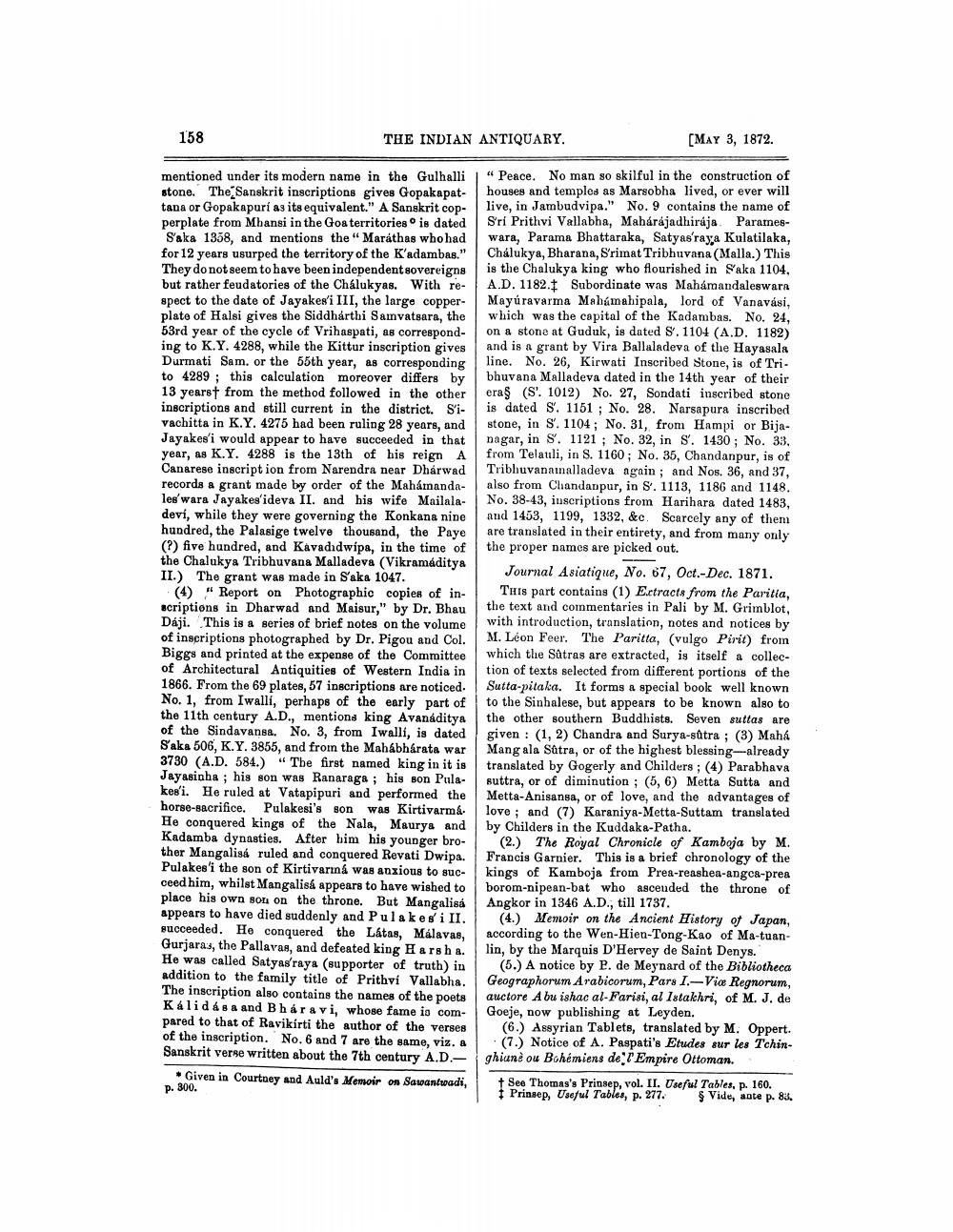________________
158
THE INDIAN ANTIQUARY.
mentioned under its modern name in the Gulhalli stone. The Sanskrit inscriptions gives Gopakapattana or Gopakapurí as its equivalent." A Sanskrit copperplate from Mhansi in the Goa territories is dated Saka 1358, and mentions the "Maráthas who had for 12 years usurped the territory of the K'adambas." They do not seem to have been independent sovereigns but rather feudatories of the Chálukyas. With respect to the date of Jayakes'i III, the large copperplate of Halsi gives the Siddharthi Samvatsara, the 53rd year of the cycle of Vrihaspati, as corresponding to K.Y. 4288, while the Kittur inscription gives Durmati Sam. or the 55th year, as corresponding to 4289; this calculation moreover differs by 13 years from the method followed in the other inscriptions and still current in the district. S'ivachitta in K.Y. 4275 had been ruling 28 years, and Jayakes'i would appear to have succeeded in that year, as K.Y. 4288 is the 13th of his reign A Canarese inscription from Narendra near Dharwad records a grant made by order of the Mahámandales'wara Jayakes'ideva II. and his wife Mailaladeví, while they were governing the Konkana nine hundred, the Palasige twelve thousand, the Paye (?) five hundred, and Kavadıdwipa, in the time of the Chalukya Tribhuvana Malladeva (Vikramaditya II.) The grant was made in S'aka 1047.
(4) Report on Photographic copies of inscriptions in Dharwad and Maisur," by Dr. Bhau Dáji. This is a series of brief notes on the volume of inscriptions photographed by Dr. Pigou and Col. Biggs and printed at the expense of the Committee of Architectural Antiquities of Western India in 1866. From the 69 plates, 57 inscriptions are noticed. No. 1, from Iwalli, perhaps of the early part of the 11th century A.D., mentions king Avanáditya of the Sindavansa. No. 3, from Iwallí, is dated S'aka 506, K.Y. 3855, and from the Mahabharata war 3730 (A.D. 584.) "The first named king in it is Jayasinha; his son was Ranaraga; his son Pulakes'i. He ruled at Vatapipuri and performed the horse-sacrifice. Pulakesi's son was Kirtivarmá He conquered kings of the Nala, Maurya and Kadamba dynasties. After him his younger brother Mangalisá ruled and conquered Revati Dwipa. Pulakes'i the son of Kirtivarıná was anxious to succeed him, whilst Mangalisá appears to have wished to place his own son on the throne. But Mangalisá appears to have died suddenly and Pulakes'i II. succeeded. He conquered the Látas, Málavas, Gurjaras, the Pallavas, and defeated king Harsh a. He was called Satyas'raya (supporter of truth) in addition to the family title of Prithvi Vallabha. The inscription also contains the names of the poets Kálidása and Bharavi, whose fame is compared to that of Ravikírti the author of the verses of the inscription. No. 6 and 7 are the same, viz. a Sanskrit verse written about the 7th century A.D.
[MAY 3, 1872.
"Peace. No man so skilful in the construction of houses and temples as Marsobha lived, or ever will live, in Jambudvipa." No. 9 contains the name of Sri Prithvi Vallabha, Mahárájadhirája Parameswara, Parama Bhattaraka, Satyas'raya Kulatilaka, Chalukya, Bharana, Srimat Tribhuvana (Malla.) This is the Chalukya king who flourished in Saka 1104, A.D. 1182. Subordinate was Mahámandaleswara Mayúravarma Mahámahipala, lord of Vanavási, which was the capital of the Kadambas. No. 24, on a stone at Guduk, is dated S. 1104 (A.D. 1182) and is a grant by Vira Ballaladeva of the Hayasala line. No. 26, Kirwati Inscribed Stone, is of Tribhuvana Malladeva dated in the 14th year of their era§ (S'. 1012) No. 27, Sondati inscribed stone. is dated S. 1151; No. 28. Narsapura inscribed stone, in S. 1104; No. 31, from Hampi or Bijanagar, in S. 1121; No. 32, in S. 1430; No. 33. from Telauli, in S. 1160; No. 35, Chandanpur, is of Tribhuvanamalladeva again; and Nos. 36, and 37, also from Chandanpur, in S. 1113, 1186 and 1148. No. 38-43, inscriptions from Harihara dated 1483, and 1453, 1199, 1332, &c. Scarcely any of them are translated in their entirety, and from many only the proper names are picked out.
Given in Courtney and Auld's Memoir on Sawantwadi,
p. 300.
Journal Asiatique, No. 67, Oct.-Dec. 1871. THIS part contains (1) Extracts from the Paritia, the text and commentaries in Pali by M. Grimblot, with introduction, translation, notes and notices by M. Léon Feer. The Paritta, (vulgo Pirit) from which the Sûtras are extracted, is itself a collection of texts selected from different portions of the Sutta-pitaka. It forms a special book well known to the Sinhalese, but appears to be known also to the other southern Buddhists. Seven suttas are given (1, 2) Chandra and Surya-sûtra; (3) Mahá Mang ala Sutra, or of the highest blessing-already translated by Gogerly and Childers; (4) Parabhava suttra, or of diminution; (5, 6) Metta Sutta and Metta-Anisansa, or of love, and the advantages of love; and (7) Karaniya-Metta-Suttam translated by Childers in the Kuddaka-Patha.
(2.) The Royal Chronicle of Kamboja by M. Francis Garnier. This is a brief chronology of the kings of Kamboja from Prea-reashea-angca-prea borom-nipean-bat who ascended the throne of Angkor in 1346 A.D., till 1737.
(4.) Memoir on the Ancient History of Japan, according to the Wen-Hien-Tong-Kao of Ma-tuanlin, by the Marquis D'Hervey de Saint Denys."
(5.) A notice by P. de Meynard of the Bibliotheca Geographorum Arabicorum, Pars I.-Vice Regnorum, auctore Abu ishac al-Farisi, al Istakhri, of M. J. de Goeje, now publishing at Leyden.
(6.) Assyrian Tablets, translated by M. Oppert. (7.) Notice of A. Paspati's Etudes sur les Tchinghiunè ou Bohémiens de l'Empire Ottoman.
See Thomas's Prinsep, vol. II. Useful Tables, p. 160. Prinsep, Useful Tables, p. 277. § Vide, ante p. 83.




